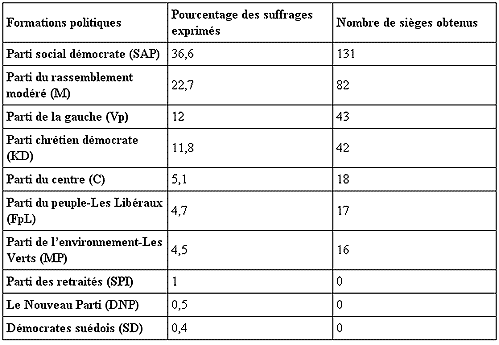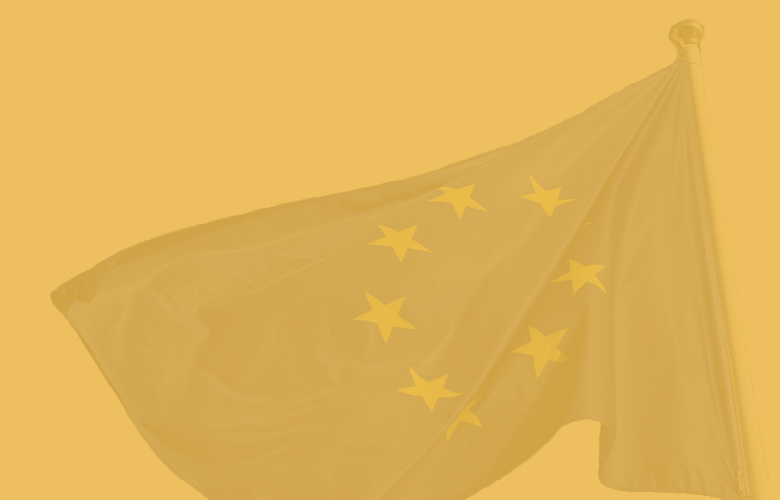News
Corinne Deloy,
Fondation Robert Schuman,
Helen Levy
-

Available versions :
EN

Corinne Deloy
Fondation Robert Schuman
Helen Levy
In a Europe that is governed, in the main, by conservative powers Sweden is an exception. Not only because it is led by a social democrat government but also because, according to all opinion polls, it is about to re-elect the same government by an overwhelming majority. This is a feature typical of Sweden and without equal in any other Scandinavian country. In addition to this it possesses another particularity. Just as the extreme right is strengthening its hold in many European countries it is singularly absent from the Swedish political scene. During the 1991 elections New Democracy (NyD), an extreme right wing group managed to win 7.2% of the vote and entered Parliament with 25 seats. But in 1994 New Democracy had fallen to 1.2% of the vote. Today the Swedish Democrats (SD), an extreme right wing party led by Mikael Jansson, is credited with only 1% of the vote by the opinion polls. The Swedish Parties were quick to commit themselves to the debate on immigration and they have always unanimously expressed their hostility to all forms of xenophobia. The Prime Minister Göran Persson likes to say that he is proud that the opposition parties accuse him of « leading policies on immigration and political refugees that are too restrictive and he boasts the maturity of Swedish political parties.
The Swedish Political System
Every four years on the third Sunday in September the Swedes are called to elect their local representatives (town and general councillors) as well as the 349 members of the Riksdag, the only house in Parliament since a revision of the Constitution in 1968 put an end to the bicameral system adopted just a century earlier. This timetable leads to the local and general elections occurring at the same time: there is an habitually high participation rate and the predominance of national political themes throughout the electoral campaign.
Sweden is divided into 29 electoral constituencies, each electing 11 Parliamentary representatives on average, the biggest of these being the capital, Stockholm which elects 38 MP's. In order to fulfil their civic duty Swedish voters can go to the ballot boxes on the day of the election and they can also vote by post during the 18 days preceding the election day. The voting method is proportional and votes are distributed according to Sainte Lagüe's modified method with a primary divider at 1.4. 310 seats are divided between 29 constituencies and the remaining 39 are so called compensatory seats, attributed to the different parties with a view to making them as representative as possible nationally. The candidates elected to these compensatory seats are found in the constituencies where their party enjoys the greater remainder. In order to take part in the distribution of these seats a party has to have won 4% of the vote nationally or 12% within a given constituency.
Since the 1998 elections, apart from having to vote for a party, voters can now choose a candidate from the lists offered to them by the parties themselves. During the count initially the number of seats gained by each party is determined. Then those candidates with the greatest number of votes against their name in each list is announced. However in order to be elected by this system a candidate has to have gained 8% of the votes won by his party in the constituency. This possible influence in the choice of elected candidates with the option of a preferential vote seems to have charmed voters. During the last elections in 1998 30% revealed their choice on their voting slip, thereby ensuring the election of one quarter of the Riksdag. Although the majority of MP's was elected in the traditional way, 12 enjoyed the advantage of this new option granted to the electorate..
Seven political parties are represented in Swedish parliament:
- The Social Democrat Party (SAP), the largest majority – have always dominated Swedish political life (the SAP came to power for the first time in 1932 and was absent for 9 years only over the last 7 decades),
- The Moderate Assembly Party (M), main opposition party lying to the right on the political scale,
- The Left Party (Vp), ex-Communist Party opposed to the European Union,
- The Christian Democrat party (KD), conservative party,
- The Centre Party (C), ex-agricultural party lying to the right on the political scale and which distinguishes itself however by its firm opposition to the European Union.
- The Peoples' Party-The Liberals (FpL), conservative opposition party,
- The Environment Party –The Greens (MP), leftwing political group and opposed to Europe.
The election stakes
The last five general elections (1985, 1988, 1991, 1994 et 1998) show a very clear domination by the Social Democrats of Swedish political life. Over the last 17 years Sweden has been governed by them except for a short period from 1991 to 1994 where it was governed by a conservative coalition led by Carl Bildt and which brought together the Moderates, the Liberals and the Christian Democrats. Although the Social Democrat Party missed winning an absolute majority of the Riksdag during the last elections in 1998 by one seat (since the establishment of mono-cameralism the SAP has never won an absolute majority in Parliament) it did however achieve its worst election result since 1922 winning only 36.6% of the votes cast. However this electoral disengagement was not favourable for their main adversary , the Moderate Party, but it mostly benefited two small parties: the Environment Party-the Greens and the Christian Democrat Party. The latter almost tripled its 1994 score (4.1%) by winning 11.8% of the vote.
Göran Persson, both Social Democrat leader and Prime Minister, who is canvassing his third term in office, is aware that he needs to widen his electorate in order to surpass the 40% vote mark. The Social Democrats are able to boast good results: economic growth is constant (2% in 2002 and over 3% planned for the coming year), taxes have dropped, family allowances have increased and unemployment is constantly on the decrease reaching 4% today (3.8% planned for in 2003). The famous Swedish model was estimated dead just a few years ago but it has succeeded in moving forwards without laying aside its fundamental principles. It demonstrates that economic liberalism and powerful State providence are not necessarily opposites.
The opposition parties (Moderates, Liberals and Christian Democrats) are however confronted with the same problem encountered at every general election – that is how to unite around a common electoral platform. Although they all agree on abolishing taxes on major fortunes such as the double taxing of shares, their positions diverge on energy policies, the European Union – the Centre Party is hostile to Brussels – and even on the family, which with health and education comprise one of the main themes of the electoral campaign..
With the election three weeks away all opinion polls show that on September 15th the Social Democrat Party carried along by the popularity of Göran Persson should demonstrate once more its ability to attract the majority of Swedish voters with its programme.. Unless a scandal erupts or a major event occurs that is able to turn the electorate the true stakes of the Swedish elections on 15th September will be to see whether the Social Democrats manage to surpass the 40% mark or not.
Reminder of the election results of 21st September 1998:
Participation : 81,4%
 Embassy of Sweden in Paris
Embassy of Sweden in ParisOn the same theme
To go further
Elections in Europe
Corinne Deloy
—
15 April 2025
Elections in Europe
Corinne Deloy
—
25 February 2025
Elections in Europe
Corinne Deloy
—
18 February 2025
Elections in Europe
Corinne Deloy
—
28 January 2025

The Letter
Schuman
European news of the week
Unique in its genre, with its 200,000 subscribers and its editions in 6 languages (French, English, German, Spanish, Polish and Ukrainian), it has brought to you, for 15 years, a summary of European news, more needed now than ever
Versions :



